History of the MG Car Club: Part 8
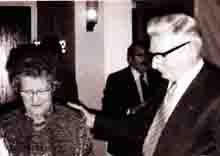
 One evening early in November 1968 I received a telephone call from our Chairman, John Thornley, to say that he had received instructions to wind up the Car Club in a manner as painless as possible. My reply was, “We had better get together then.” We both felt that ways and means must be found to carry on with the work and achievements of the preceding 40 years.
One evening early in November 1968 I received a telephone call from our Chairman, John Thornley, to say that he had received instructions to wind up the Car Club in a manner as painless as possible. My reply was, “We had better get together then.” We both felt that ways and means must be found to carry on with the work and achievements of the preceding 40 years.
We arranged a meeting and in the meantime I talked things over with Tom Hazlem, the then Chairman of the South East Centre, so that when I met John I was able to put forward what Tom and I had agreed was a reasonably practical plan for the continuance of the MG Car Club as an entirely independent body.
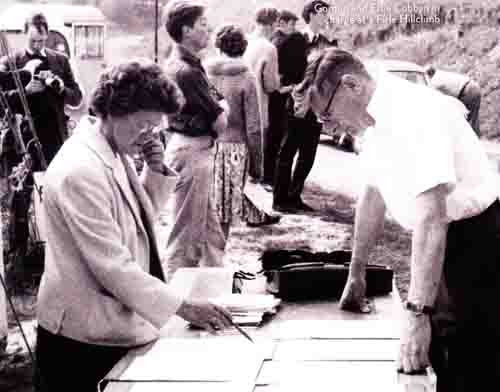
In our opinion, part of the plan hinged upon our succeeding in persuading Margret O’Brien, who at that time had some 15 years’ service with B.M.C. and consequently accrued certain pension rights, to leave and come over to our projected independent MG Car Club. At that stage it would have been premature to mention this to Margret. At my meeting with John it was agreed that an ad hoc meeting of the elder statesmen of the Club should be called at the earliest possible moment to discuss the future.
Fortunately over the years a very considerable force of grey haired gentlemen, who really had the affairs of the MG Car Club at heart and at the same time were realistic in their outlook towards motor sport and the MG Car Club in particularly, had become an integral part of the Club.
On Friday, November 15, 1968, the meeting took place at Abingdon and all UK Centres were represented. After John Thornley had outlined the current situation, considerable discussion took place as to the future of the Club.
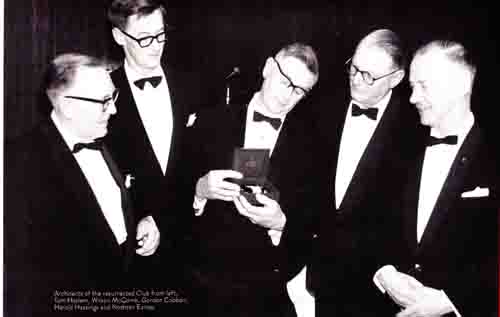
Prior to the meeting Tom and I had burnt a considerable amount of midnight oil in drawing up plans, including financial budgeting, and were firmly of the opinion that whilst a struggle for the first two or three years might well ensue, it was a feasible proposition to go it alone, providing we had the full support of the remainder of the UK Centres. Our plans were discussed and finally agreed and I came away from the meeting wearing the hat of the honorary general secretary which office I agreed to accept for six months. One of the items upon which much thought was given at the meeting was the method of communication, and it was fully agreed that a form of bulletin covering the whole of the Club’s activities was absolutely essential if the Club was going to be held together; and it was left that we were given the authority to take appropriate action forthwith to get the magazine off the ground.
After the meeting we met Margret and put forward our ideas for crossing hurdle number one and left it with her to sort out in her own mind. From her angle there was much to be considered, and to attempt to arrive at a decision without adequate time to weigh up all aspects could only lead to embarrassment at a later date. Two weeks later we were very relieved to get a “Yes” and plans then proceeded to find suitable office accommodation.
We then approached the second hurdle, which was to devise a suitable Club magazine, and to this end various quotations and ideas were considered. Martin Brent, at that time the Secretary of the SVW Register; was approached and informed that in our opinion he would make a very good editor of the new magazine and that he had better set to work because we wanted the first issue available for the Racing Car Show around January 2. As he didn’t put up too good a case for not doing the job, he got it!
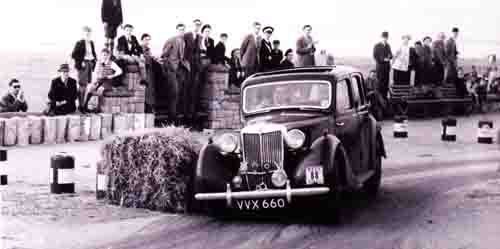
Frantic discussions took place with British Leyland in an attempt to get their consent to the use of the title Safety Fast! and it was only at the very last moment before going to press that consent was received. We also had a battle on our hands to obtain a licence to continue with the title of the Club as it had stood for the last 40 years, but again in this we eventually succeeded.
With five weeks to go, Martin got down to work compiling the first issue of the new look Safety Fast! and on Boxing Day of that year I met Martin in London. He handed over to me the make up for that first issue, which I immediately took to the printers at Southend, with the result that the publication was on the stand at the Racing Car Show from the word go. This was a fantastic achievement on Martin’s part and the Club owes much to him for the initial work he put into the publication, and for continuing as its Editor for the next two years. He then handed the editorial chair to Mike Allison, who ultimately passed it to Steve Glenn.
The first two years of our independence produced considerable concern as to our financial situation; however, thanks to the expert guidance of Tom Hazlem, who had by then become our treasurer we survived. During the first year Tom put in a tremendous amount of work in compiling the Memorandum and Articles of Association of the MG Car Club Limited, so that on October 25, 1969 the Club held the first meeting of the Council of the MG Car Club at the Hyde Park Hotel, Knightsbridge and we were on our own.
Here I would like to thank all of the UK Centre officers and committees for the support and backing they gave during our early years of independence and for the support they continue to give to the present day. So far as overseas Centres were concerned, the majority of them re-affirmed their affiliation to the parent Club and it is encouraging to note that both in number and stature considerable progress has been made during our six years of independence.
Thus today we have no fewer than 38 overseas Centres which are extremely active, and many support us by forming parties to come over and take part in UK events. There have also been quite a number of very successful visits to the European Centres, which have been supported extremely well and our thanks are due to them for their tremendous hospitality.
To sum up I think that in our independent state our Club has grown in stature and is respected in all fields of motor sport and I would like to thank the founder members of the Club, John Thornley, Harold Hastings, Norman Eames, for the foundations they laid so well and truly in 1930 and upon which the Club today stands.
Gordon Cobban’s career started when he worked as a joiner before being called up to serve in the Royal Engineers. After the war he established a successful building company in Ilford, Essex. His interest in motor sport and MGs stemmed from his friendship with locally based Dick Jacobs, and Gordon campaigned a series of cars including YB, TE MGA and a 1300 in national and international events sometimes as navigator in rallies. He joined the MGCC in 1953 and by 1955 he was on the SE Centre Committee and became Centre Secretary in 1958. For a decade he led the SE Centre from strength to strength, handling the organisation of all types of competition events. In 1968 when British Leyland withdrew support from the Clubs, Gordon found himself General Secretary of the whole Club with no office, no funding, no secretary, no way of producing Safety Fastl and no authority to continue the use of the MGCC name. It was largely due to Gordon that the Club survived as his office and staff became the Club HQ for some 12 years. He took over the organisatron of the Club’s races and sprints building up Silverstone in particular and was always supported by his wife Elsie. Gordon died in November 1994.
Tom Hazlem was a keen rally driver in the 1950s and a member of the Council of the then renowned London Motor Ctub. Here he gained a tremendous amount of experience, not only as a competitor but also as an organiser and administrator. His profession as an accountant and fondness and dedication to motor sport and motor club life resulted in his becoming ever more involved in Club administration. He joined MGCC in 1957 and in 1960 was elected to the South Eastern Centre Committee and after taking a prominent part in the organisation of the Centre motor sport activities, he took over as Centre Chairman in 1967.
Before many months had elapsed the financial problems at BMC began to emerge and these set Tom thinking of the future of the Club should financial and other support be withdrawn. No time was wasted and when the axe fell in November 1968, Tom was able to present to a meeting of the elder statesmen, convened by John Thornley detailed financial and practical plans for the Club to continue independently of works support. The plan was accepted and was the basis of the independent organisation.
Using his wide experience and the knowledge of the pitfalls other similar organisations had fallen into, resulting sometimes in their almost complete demise, Tom spent much midnight oil in drawing up the Memorandum and Articles of Association of the MG Car Club in such a way that the difficulties experienced by others would be avoided.
Bill Wallis – Club President 1996 – 2010
Gordon Cobban acknowledged the part which senior members of the Club, and particularly those from the Centres, played in restoring the Club to a new future after the withdrawal of British Leyland support – Bill Wallis was certainly at the forefront of this revival.
Bill’s association wlth the MG Car Club started in 1948 when he was involved with the recreation of the Midlands Centre after the war. He joined the Centre Committee in 1949 and immediately turned his hand to becoming involved in all aspects of the Club’s activities soon becoming Centre Chairman.
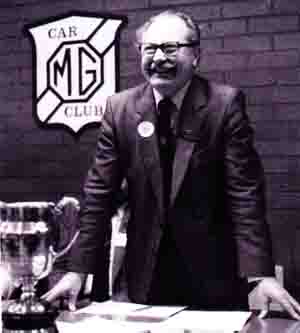
Bill was asked to take over as Club Chairman when British Leyland support for the clubs was withdrawn, and his skillful handling of affairs during these difficult times did much to help the Club survive.
In 1996 he took over as Club President from John Thornley, a post which he filled with tremendous dedication and enthusiasm for a remarkable 14 years until his death in 2010.
Bill had boundless enthusiasm for being involved with so many Club activities where he was blessed with the skill of always saying the right thing at the right time – and always with great wisdom and sincerity. Bill was always supported by his wife, June, who herself was involved in several Club activities.
It is appropriate that his name will be remembered with the completion of the new Bill Wallis Archive extension to Kimber House.
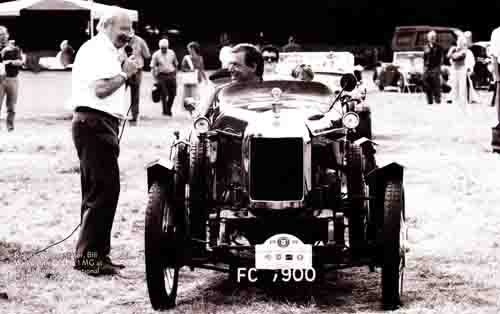
NAMGAR would like to thank Andy Knott, Editor, Safety Fast! for his kind permission to reproduce these articles.

